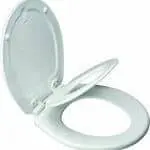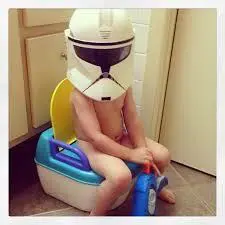“Mommmmmm! Wipe my butt!” Ah, the glamorous life of parenthood. You know, I felt sort of cheated with my first spawn. We plugged away at potty training, finally ditched diapers, and I thought my days of poop duty were over until spawn 2.0 came around, that is until the first time I was beckoned to the bathroom to wipe a butt. Not enough parents talk about the fact that lots of toddlers have trouble wiping even after potty training. Now well into spawn 4.0, I have found a few things seem to help kids learn to wipe after they use the toilet—though sadly you’ll probably still be washing out some skid marks for awhile…. Speaking of which….
Just when should a kid be able to wipe their own butt?
Like many milestones butt wiping has quite the range. Some kids get it from get-go (not very many), while others struggle with it up into grade school, but school really is the decider. Even preschool teachers are likely going to decline a holler from the bathroom to wipe a butt. This means the ability to wipe one’s butt is a milestone that you don’t want so much to just let happen on its own time, because ideally, your child should have it mostly down by age 4 to 5 depending on when you intend to start school. If your child takes their sweet time, don’t feel too bad, our 6-year-old still preferred to wash his butt in the tub until just a few months back.
Okay, so how are you going to get your child wiping their own butt by age 4?
-Be instructional from the beginning. From the very start of potty training explain to your kiddo how you’re wiping and why. Show them how to hold the paper, which direction to wipe, that they can stand if they need to, that they need to keep wiping until the paper comes back clean, as well as how much toilet paper they really need, and how to properly wash their hands afterward. You’d be surprised how the simple things we don’t really think about as adults can trip up a child learning. Once they get more familiar with the potty and using it, let them wipe, but stand by and supervise at first. Walk them through it if needed until they have it down and just need more practice.
-Buy flushable wipes at first. Like the training wheels of butt wiping these things really are worth the slight expense. You can eventually phase them out, but they can be a great confidence builder. Unfortunately, these aren’t as flushable as implied, especially if you have a septic, so keep a small trash nearby.

-Put a full-body mirror in the bathroom. If you put a mirror in the bathroom your kid can check their own crack for stragglers rather than calling you in to examine spread cheeks. It makes it easy for kids to check that they got it all, is what I mean.
-Offer rewards. The same way you (probably) resorted to some bribery to get your child to potty train, offer a reward for wiping properly—give a reason to try a little harder and skip lazy wipers. This might be the promise of some new cool undies, treats, stickers, whatever works for you. I found undies worked well because I could use character ones, then remind my son not to “get poop on Jake the Pirate.” This worked surprisingly well.
What if it just isn’t working? What do you do then?
-Troubleshoot. Find out if there is a reason your child is having trouble learning. Some kids are grossed out by their own poop (like my shower rinser). Others don’t have the coordination to reach around. Some may have underlying medical issues leading to leaks that make it look like they wipe poorly. Talk with your child, but be careful not to paint the issue as something they’ve done wrong (though some kids are just lazy wipers.)
-Increase the frequency of baths. This isn’t going to help your child learn to wipe, but it will help them smell better and suffer less itchy crack, rashes, and other unpleasantries.
-Make their teachers or care provider aware. If your child does hit school and still is a less than stellar wiper, quietly disclose that to their teacher. Let them know if your child may need a little extra toilet time or to bring a small bag with wet wipes along with them to the bathroom.
-Be patient. All in all the above might help, but it’s no guarantee your child’s going to get it. Be patient, and hang in there.

